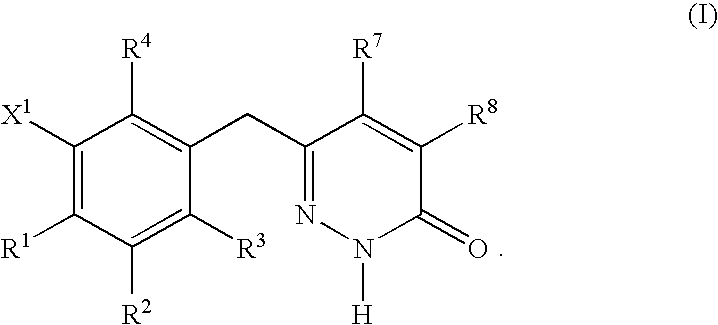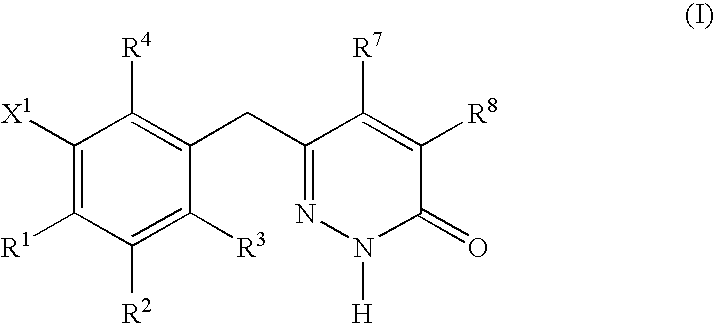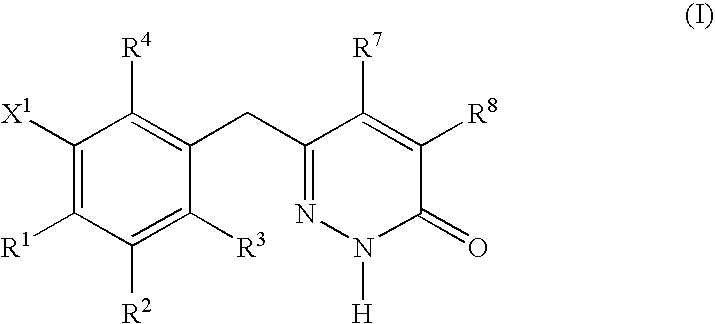Non-nucleoside reverse transcriptase inhibitors
a reverse transcriptase inhibitor and non-nucleoside technology, applied in the field of antiviral therapy, can solve the problems of slowed disease progression, significant therapeutic problems, and high viral load
- Summary
- Abstract
- Description
- Claims
- Application Information
AI Technical Summary
Problems solved by technology
Method used
Image
Examples
example 1
Ethyl 4-Chloro-3-methoxyphenylacetate
Step 1
A solution of 4-chloro-3-methoxytoluene (9a; 0.5 g; 3.2 mmol), NBS (0.57 g; 3.2 mmol) and benzoyl peroxide (0.031 g; 0.13 mmol) and 32 mL of DCE were heated at reflux for 3 h. The reaction mixture was cooled, diluted with CH2Cl2 and washed with water and brine. The organic extract was dried filtered and evaporated to yield the bromomethyl compound 9b which was used without further purification.
Step 2
The 28 g (0.166 mmol) of 9b from the previous step, NaCN (28 g; 0.58 mmol; 3.5 equiv.) and 500 mL of 90% aqueous EtOH were stirred at room temperature overnight. The crude residue was partitioned between EtOAc / H2O (359 mL of each), washed with brine, dried, filtered and evaporated. Silica gel chromatography and elution with a gradient (100% hexane→90:10 hexane:EtOAc) yielded 21 g of 9c.
Step 3
Gaseous HCl was slowly bubbled into a cooled solution of 4-chloro-3-methoxyacetonitrile (9b) in toluene (10 mL), ether (10 mL) and EtOH (1 mL) for about 10 ...
example 2
6-[3-(2-chloro-phenoxy)-4-methylbenzyl]-2H-pyridazin-3one
Step 1
To a cooled solution of ethyl 4-hydroxy-3-methoxyphenylacetate (4a; 13.7 g; 65.2 mmol) and 260 mL of CH2Cl2 under N2 atmosphere was added dropwise triflic anhydride (16 mL; 97.9 mmol) followed by dropwise addition of pyridine (8.9 mL; 8.8 mmol). The reaction was stirred in an ice-water bath for 3 h. The solution was transferred to a separatory funnel and washed with water and brine, dried (Na2SO4), filtered and evaporated to yield 21 g (90%) of 4b.
Step 2
To a solution of ethyl 3-methoxy-4-trifluorosulfonyloxyphenylacetate (4b) in 4 mL of THF cooled in an ice-water bath was added slowly a solution of Pd(dppf)Cl2 (0.024 g; 0.029 mmol) and DIBAL-H (6 mL; 0.058 mmol; 1.0M in PhMe)and a small quantity of THF followed by dimethylzinc (0.29 mL; 0.58 mmol; 2.0 M in PhMe). After addition was completed the ice bath was removed and the reaction allowed to warm to rt and then heated to reflux for 1 h. The reaction was carefully quenc...
example 3
3-(2-Chloro-phenoxy)-4-ethyl-phenyl]-acetic acid ethyl ester
Step 1
To a stirred solution of ethyl 3-methoxyphenylacetate (16.0 g; 82.38 mmol) in CH2Cl2 (200 mL) at rt was added dropwise AcCl (9.88 mL; 138.9 mmol) followed by stannic chloride (16.9 mL; 169 mmol; 1.0 M solution in CH2Cl2). The reaction mixture was stirred at rt for 6 h and poured into an ice-water mixture. The aqueous phase was extracted with CH2Cl2 and the combined extracts were washed with water, dried (Na2SO4) and the solvent removed in vacuo. The crude product 4e was purified by chromatography on silica gel and eluted with CH2Cl2:EtOAc (20:1) to yield 13.96 g (69.5%) of a white solid.
Step 2
To a solution of 4e (19 g; 80.42 mmol) and 200 mL of TFA cooled to 0° C. was added an excess of Et3SiH and the reaction allowed to warm to rt for 3 h. Excess TFA was removed in vacuo and the residue partitioned between water and CH2Cl2. The crude product was purified by chromatography on silica gel and eluted with CH2Cl2:hexane (...
PUM
| Property | Measurement | Unit |
|---|---|---|
| weight loss | aaaaa | aaaaa |
| chain elongation | aaaaa | aaaaa |
| elongation | aaaaa | aaaaa |
Abstract
Description
Claims
Application Information
 Login to View More
Login to View More - R&D
- Intellectual Property
- Life Sciences
- Materials
- Tech Scout
- Unparalleled Data Quality
- Higher Quality Content
- 60% Fewer Hallucinations
Browse by: Latest US Patents, China's latest patents, Technical Efficacy Thesaurus, Application Domain, Technology Topic, Popular Technical Reports.
© 2025 PatSnap. All rights reserved.Legal|Privacy policy|Modern Slavery Act Transparency Statement|Sitemap|About US| Contact US: help@patsnap.com



